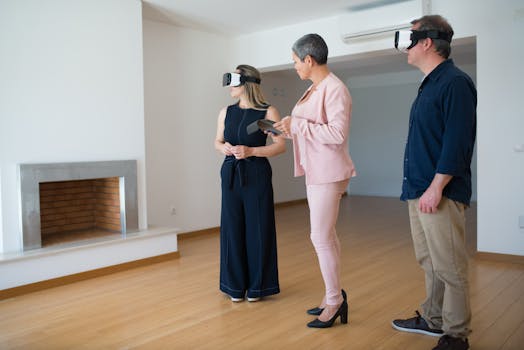
Smart Homes and Smart Living: The Technological Transformation of European Homes by 2025
Smart Homes and Smart Living are revolutionizing the way we live, work, and interact with our living spaces. By 2025, European homes are expected to undergo a significant technological transformation, making them more efficient, comfortable, and sustainable.
Introduction to Smart Homes
A smart home is a residence that has been equipped with advanced technology to make it more convenient, energy-efficient, and safe. Smart homes use a combination of sensors, cameras, and automated systems to monitor and control various aspects of the home, such as lighting, temperature, security, and entertainment.
Benefits of Smart Homes
- Energy efficiency: Smart homes can optimize energy consumption by automatically turning off lights, heating, and cooling systems when not in use.
- Increased safety: Smart homes can detect potential hazards, such as gas leaks, fires, and intruders, and alert homeowners and emergency services.
- Convenience: Smart homes can be controlled remotely, allowing homeowners to adjust lighting, temperature, and entertainment systems from anywhere.
Technological Advancements in Smart Homes
Several technological advancements are driving the growth of smart homes in Europe, including:
- Internet of Things (IoT): The IoT refers to the network of physical devices, vehicles, and other items that are embedded with sensors, software, and connectivity, allowing them to collect and exchange data.
- Artificial Intelligence (AI): AI is being used in smart homes to learn the habits and preferences of homeowners and make adjustments to optimize energy efficiency, comfort, and safety.
- 5G Connectivity: The rollout of 5G connectivity is enabling faster, more reliable, and lower-latency communication between devices, making it possible for smart homes to respond quickly to commands and changes.
European Smart Home Market Trends
The European smart home market is expected to grow significantly by 2025, driven by increasing demand for energy efficiency, convenience, and safety. Key trends in the European smart home market include:
- Adoption of voice assistants: Voice assistants, such as Amazon Alexa and Google Assistant, are becoming increasingly popular in European smart homes, allowing homeowners to control their living spaces with voice commands.
- Integration of smart home devices: Smart home devices, such as thermostats, lights, and security cameras, are being integrated to create seamless and automated experiences.
- Focus on sustainability: European smart homes are prioritizing sustainability, with a focus on energy-efficient systems, renewable energy sources, and eco-friendly materials.
Challenges and Limitations of Smart Homes
While smart homes offer many benefits, there are also challenges and limitations to consider, including:
- Security risks: Smart homes can be vulnerable to cyber threats, such as hacking and data breaches, which can compromise homeowner safety and security.
- Interoperability issues: Different smart home devices and systems may not be compatible, making it challenging to integrate and control multiple devices.
- High costs: Smart home technology can be expensive, making it inaccessible to many homeowners, particularly in lower-income households.
Conclusion
Smart Homes and Smart Living are transforming the way we live, work, and interact with our living spaces. By 2025, European homes are expected to be more efficient, comfortable, and sustainable, with a focus on technological advancements, sustainability, and convenience. While there are challenges and limitations to consider, the benefits of smart homes make them an exciting and promising development for the future of European homes.
Future of Smart Homes
The future of smart homes is expected to be shaped by emerging technologies, such as augmented reality, blockchain, and quantum computing. These technologies will enable new features and capabilities, such as:
- Immersive experiences: Augmented reality will enable homeowners to interact with their living spaces in new and innovative ways, such as virtual decorating and furniture arranging.
- Secure data storage: Blockchain technology will provide a secure and decentralized way to store and manage smart home data, protecting homeowner privacy and security.
- Advanced AI: Quantum computing will enable advanced AI capabilities, such as predictive maintenance and personalized recommendations, to make smart homes even more efficient and comfortable.
Real-World Examples of Smart Homes
Several companies and organizations are already showcasing the potential of smart homes, including:
- Smart home manufacturers: Companies like Samsung and Apple are developing smart home devices and systems that integrate with their existing product ecosystems.
- Home builders: Home builders, such as Lennar and Meritage Homes, are incorporating smart home technology into new construction projects, making it easier for homeowners to adopt smart home solutions.
- Research institutions: Universities and research institutions, such as the Massachusetts Institute of Technology (MIT) and the University of California, Berkeley, are exploring new technologies and applications for smart homes, including energy-efficient systems and sustainable materials.
Impact of Smart Homes on Society
Smart homes have the potential to impact society in many ways, including:
- Increased energy efficiency: Smart homes can optimize energy consumption, reducing the strain on the grid and mitigating climate change.
- Improved healthcare: Smart homes can monitor and support the health and well-being of occupants, particularly older adults and people with disabilities.
- Enhanced safety: Smart homes can detect and respond to potential hazards, such as fires and intruders, reducing the risk of injury and property damage.
Conclusion
Smart Homes and Smart Living are transforming the way we live, work, and interact with our living spaces. By 2025, European homes are expected to be more efficient, comfortable, and sustainable, with a focus on technological advancements, sustainability, and convenience. As the smart home market continues to grow and evolve, we can expect to see new innovations, applications, and benefits emerge, shaping the future of European homes and society as a whole.
Smart Home Automation
Smart home automation refers to the use of technology to control and automate various systems and devices in the home, such as lighting, temperature, security, and entertainment. Smart home automation can be achieved through a variety of means, including:
- Hub-based systems: Smart home hubs, such as Samsung SmartThings and Wink Hub, connect and control multiple devices, allowing homeowners to automate and customize their smart home experiences.
- Cloud-based services: Cloud-based services, such as IFTTT (If This Then That) and Stringify, enable homeowners to create custom automation recipes and integrate multiple devices and services.
- Voice assistants: Voice assistants, such as Amazon Alexa and Google Assistant, can be used to control and automate smart home devices, making it easy to adjust lighting, temperature, and entertainment systems with voice commands.
Smart Home Security
Smart home security refers to the use of technology to secure and protect the home, including doors, windows, and valuables. Smart home security systems can include:
- Door and window sensors: Sensors can detect when doors and windows are opened or closed, alerting homeowners to potential security breaches.
- Security cameras: Security cameras can monitor the home and surrounding areas, providing video evidence in the event of a security incident.
- Alarm systems: Alarm systems can sound a loud siren and alert emergency services in the event of a security breach.
Smart Home Energy Management
Smart home energy management refers to the use of technology to monitor and control energy consumption in the home, reducing waste and optimizing energy efficiency. Smart home energy management systems can include:
- Energy monitors: Energy monitors can track energy consumption in real-time, providing insights into energy usage and identifying areas for improvement.
- Smart thermostats: Smart thermostats can learn the habits and preferences of homeowners, adjusting heating and cooling systems to optimize energy efficiency and comfort.
- Renewable energy systems: Renewable energy systems, such as solar and wind power, can generate clean energy and reduce reliance on the grid.
Conclusion
Smart Homes and Smart Living are transforming the way we live, work, and interact with our living spaces. By 2025, European homes are expected to be more efficient, comfortable, and sustainable, with a focus on technological advancements, sustainability, and convenience. As the smart home market continues to grow and evolve, we can expect to see new innovations, applications, and benefits emerge, shaping the future of European homes and society as a whole.
Smart Home Entertainment
Smart home entertainment refers to the use of technology to enhance and customize the entertainment experience in the home, including music, video, and gaming. Smart home entertainment systems can include:
- Streaming devices: Streaming devices, such as Roku and Chromecast, can access a wide range of entertainment content, including movies, TV shows, and music.
- Smart speakers: Smart speakers, such as Amazon Echo and Google Home, can play music, podcasts, and audiobooks, and control other smart home devices.
- Gaming systems: Gaming systems, such as PlayStation and Xbox, can provide an immersive gaming experience, with advanced graphics and controller technology.
Conclusion
Smart Homes and Smart Living are transforming the way we live, work, and interact with our living spaces. By 2025, European homes are expected to be more efficient, comfortable, and sustainable, with a focus on technological advancements, sustainability, and convenience. As the smart home market continues to grow and evolve, we can expect to see new innovations, applications, and benefits emerge, shaping the future of European homes and society as a whole.




